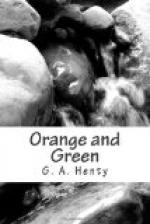On the first shock of the Irish infantry, the four regiments broke and fled. They were hotly pursued, and slaughtered in great numbers, the Irish cavalry pouring through the openings in the hedges which had been prepared for them. At length, the fugitives reached the edge of the bog, where they gathered in a confused mass; which the officers, in vain, attempted to form into order. The cavalry charged down upon them, broke and scattered them, and drove them into the morass, followed by the Irish infantry, who were better acquainted with the ground, and more accustomed to traversing bogs. The soldiers were driven into the deepest and most difficult portion of the morass, and a great slaughter took place.
The British artillery were planted on the edge of the morass, but so mingled were the two parties that they were unable to fire. Great numbers of the English were killed. Colonels Earl and Herbert, with many officers and men, were taken prisoners, and the remnant of the British were driven completely across the bog, to the shelter of their own cannon.
While this was passing in the centre, another division of Ginckle’s army, consisting of English and French infantry, had crossed the bog by a passage more to the right. They also had met with no opposition in passing, and it was only when they reached the hedges, on the firm ground, that the Irish showed themselves, fired, and retreated. This division, more cautious than that of Earl, could not be tempted to pursue, but contented themselves with maintaining their ground under a heavy fire, awaiting anxiously the arrival of the British horse. They could see, however, no sign of them, but could perceive the Irish cavalry descending in large masses, preparing to charge, while the infantry were forming for an advance.
So far the Irish had been successful at every point. They had repulsed every attack made by the British left; had crushed the brigade, composed of the flower of the British infantry, which had assaulted the centre; and were now preparing to destroy the division which stood, unsupported, on their side of the bog.
At this moment, a tumult was heard on the left wing of the Irish, the direction from which the British division expected relief, and the Irish, aware of the importance of the pass of Aughrim, suspended their attack to await the events there.
Saint Ruth had directed the operations of the battle with as much skill as he had prepared for the assault. He had taken up his position on a point of the hill whence he had a complete view of the whole field of battle, and had moved his troops, with calmness and judgment, to meet each of the attacks made upon them; and when he saw the destruction of the English regiment in the centre, he exclaimed, in the full confidence of victory, “Now I will drive the English to the walls of Dublin!”




